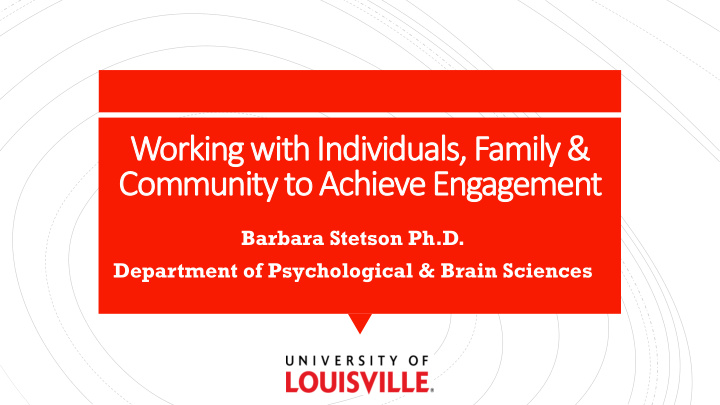



Working with Individuals, Family & Community to Achieve Engagement Barbara Stetson Ph.D. Department of Psychological & Brain Sciences
Background & Application to Diabetes ▪ Professor of Psychological & Brain Sciences, Dir. Clinical Training ▪ Licensed Clinical Psychologist Behavioral ▪ Health Behavior Change Research Lab Medicine ▪ Health Psychology is part of Perspectives on interdisciplinary field of Behavioral Diabetes Medicine ▪ Chronic Disease Prevention & Risk Reduction, Diabetes Focus
Working with Individuals, Family & Community to Achieve Engagement ▪ Learn about Ecological Approach to Diabetes ▪ Consider Barriers to Change Across System Levels Objectives ▪ Examples of Varied Needs & Perspectives ▪ Examples Successful Community Programs With Impact Across Levels ▪ Take Aways
The Ecological Approach to Diabetes ▪ Diabetes self-management takes place in homes, families, neighborhoods, workplaces, clinics, & community. ▪ People with diabetes are part of complex, Diabetes is part of multilayered system; barriers in each layer & a Complex, interaction may hinder lifestyle management. Multilayered ▪ Responsibility shared among patients, families, System providers, communities, healthcare systems & payers. ▪ Diabetes prevention and risk reduction may be viewed within this ecological perspective. Galiviz & Ali. Ch pp 463-476. In Rodriguez-Saldana (Ed.) 2019. The Diabetes Textbook. Clinical Principles, Patient Management and Public Health Issues. Springer, Cham
The Health Impact Pyramid Age, Gender, Resources, Beliefs, Affect, Social, Provider Communication, Empathy, Types and Levels Program Awareness of Health Immunizations Interventions E.g. safe roads, clean water Education, poverty, relative deprivation, exposures Frierden, Am J Public Health. 2010;100:590 – 595.
UNDERSTANDING BARRIERS CAN HELP ENGAGEMENT & OUTCOMES Barriers to Prevention and Care Across the Continuum
Objective and Perceived Diabetes Risks: Considerations for Engagement Some Knowledge of Risk Factors Regular Fast Food Intake (2+ /week) Young Adults At- Low fruit/vegetable Intake (1.27 /day) Risk for Diabetes (1 st st or 2 nd nd degree (1 Overweight/Obese (60%) relative; sedentary) Minimal Preventive Care Low Personal Perceived Risk
Daily Routine and Social Influences: Considerations for Engagement Tech Bedtime Routine? Yes 87% Bedtime Social Media - 89% of days Sedentary Young Use to Keep up Socially – 79.7% Adults Instagram, Tik Tok, SnapChat, YouTube Perceived Stress Levels High Stetson et al, Unpublished data
PERCEIVED SOURCES OF DIABETES CARE SUPPORT Media/Policy Organizations Diet Support Older adults Family & Friends with Type 2 Age 65 and older Personal Age 50-64 diabetes, using Neighborhood insulin Work/Volunteer Health Providers * 0 2 4 6 *All subscales positively associated with diabetes self-efficacy and diet adherence in those < age 65. Strongest associations for personal and neighborhood/community support scales . Only diet specific support associated with diet adherence in the older group. Ward, J.E. et al. (2014). Presentation, Society of Behavioral Medicine Annual Meeting.
SAMPLE SUCCESSFUL COMMUNITY PROGRAM: CORNER STORES ▪ Assess 29 corner stores in 4 food deserts ▪ Proprietor interest ▪ Surrounding area residential or public housing, likelihood of foot traffic or walk to schools, child-care, churches. Increase fresh ▪ Process identified 5 stores with at least 1 store in each food desert. fruits & vegs, 3-TIERED CAMPAIGN – BASED ON wheat bread, STAKEHOLDERS lowfatmilk in low KNOWLEDGE, ATTITUDES, EXPERIENCES income areas ▪ Store Owners ▪ Neighbors ▪ Clergy ▪ Housing, Food, Social Service Organizations ▪ Community Larson et al.. Prev Chronic Dis NEED FOR SUSTAINABILITY, INCREASE 2013;10:130008. REACH
Sample Successful Community Programs: Farmer’s Markets ▪ Farm stands paced outside of community sites in low-income areas of Austin 1 x week increased fruit / vegs among people within walking Availability distance 1 promotes ▪ Low-income shoppers with diabetes in rural SC engagement increased fruit / vegs by 1.6 servings per day using incentive program at farmers market located at a health center 2 ▪ In LA farmers market shoppers, 55% felt the market increased their community connection 3 1 Evans, et al, Health Place;2012, 18(5):1137-43 2f Freedman, et al, Preventive Med, 2013 May;56(5):288-92 3 Farmer’s Market Coalition; McCarthy, 2019. Marketumbrella.org
Working with Individuals, Family & Community to Achieve Engagement ▪ Influences Cut Across System Levels ▪ Needs and Perspectives Vary Across Populations Take Aways ▪ Successful Community Engagement Considers Stakeholders ▪ Interdisciplinary Approaches Maximize Engagement & Impact
Contact info: Communicate (barbara.stetson@louisville.edu) Coordinate Collaborate!
Recommend
More recommend